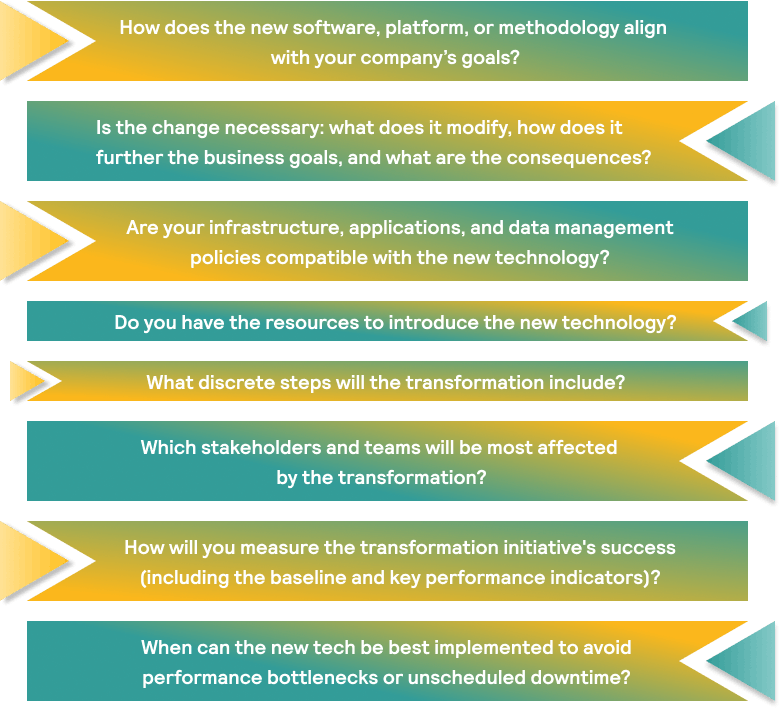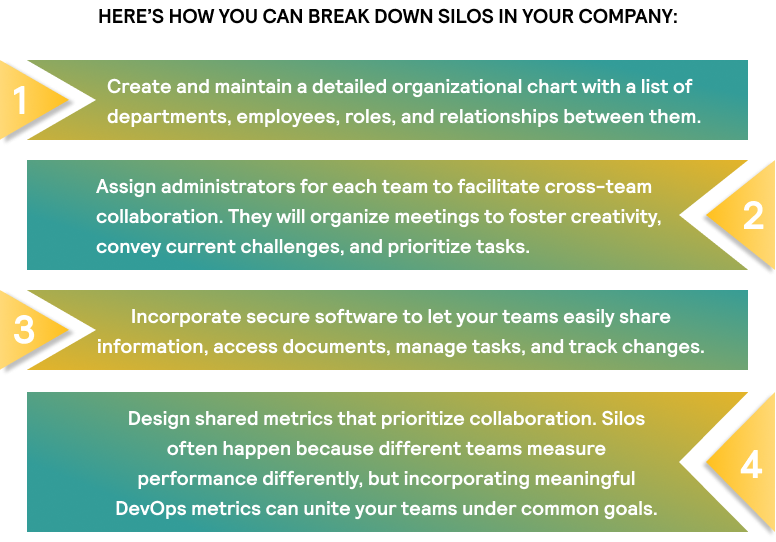Significant transformations, be it the adoption of cloud platforms, development methodology, or software, require substantial investments and may cause employee resistance. A complex project developed by multiple teams is another critical situation when change management is needed.
Let’s see how you can enhance your business DevOps change management to boost the chance of success for your initiatives and projects.
1. Analyze the business benefits of new technology
Successful transformation begins with an understanding of your current situation. Companies with poor change management can purchase expensive technology without understanding their workflows, resource utilization needs, or security requirements. As a result, their employees resist adoption, which often renders these tools pointless.
Any significant change should follow an in-depth business analysis, which should help you answer the following questions:

Senior management is often cautious of large shifts. So, you will benefit from implementing new technologies or functionalities gradually, starting with those that enhance your business the most using minimal resources.
2. Involve employees in change management
You should co-create transformation initiatives with your workforce rather than force them to change. According to Gartner’s Changing Change Management survey, such inclusive principles increase the chance of a successful change by up to 58% and decrease the implementation time by around a third.
Ask employees for feedback through surveys, polls, and open dialogue sessions. Larger organizations can assign managers to specific teams or departments to collect employee opinions faster.
It’s a good idea to launch pilot programs on a limited number of your personnel before organization-wide implementation. For example, you may appoint selected teams to test a new reporting tool to collect first-hand impressions. This can help you understand if it’s as helpful as you predicted.
Transparency about changes improves employee engagement by 38% and increases their intent to stay with the company by nearly half. You can create implementation teams to convey the company's challenges and the ways new technology can solve them to your employees.
3. Train and upskill your employees
Another DevOps change management practice is to assume that new tools are intuitive to new employees. This may be true for a developer or HR leader, but not necessarily for middle managers and rank-and-file employees.
Companies should provide employees with opportunities to upskill and reskill for new technology. Many enterprise-grade platforms come with training modules and online manuals. But if this is insufficient, you should invest in training sessions or even create a proprietary knowledge base.
Transformative shifts may require hiring subject matter experts to help your company adapt to workflow changes. Larger companies can train team leaders and appoint mentors to instruct other employees.
4. Implement a DevOps change request management process
Companies often miss many procedural elements of change management in software development. A change request system can help all relevant stakeholders initiate, assess, and manage project modifications. Here’s how it works.
A team member creates a change request document with a proposal to improve something, alter technical requirements, or fix a critical bug. The document should state how the change will solve the problem or improve an internal process. It also helps if the initiator can estimate the time and cost of the change.
Stakeholders assess the validity of the proposition, the possible risks of introducing or ignoring the change, and the way it affects other processes. Based on the review, the change request can be rejected, reworked, implemented, or escalated to upper management.
5. Divide development into smaller batches
It’s easier to manage the change in smaller increments. Companies that incorporate Three Ways DevOps practices (more on that later) tend to split the code into modules and develop in batches. This ensures that the code modifications are easier to integrate, test, and deploy into the development pipeline.
In time, companies should move from monolith software architecture towards modularity. This requires you to decompose systems, databases, and computing resources into loosely coupled, independent components called microservices. Doing so facilitates changes in services, as errors in one won’t disrupt the entire system.
6. Break down organizational silos
And the last item on our list of practices for DevOps change management is organizational silos. Silos, or independent business divisions, are certified innovation stoppers and agility killers. They can happen in startups and large enterprises, but the bigger the company is the more harmful they are. Let’s explain why briefly.
A siloed team doesn't want to collaborate unless it benefits itself. It affects information sharing across the company and, more importantly, prevents teams from forming trust. Productive change management is virtually impossible if the operations team doesn’t report a bug to the developers out of fear of repercussions.
Here’s how you can break down silos in your company:
- Create and maintain a detailed organizational chart with a list of departments, employees, roles, and relationships between them.
- Assign administrators for each team to facilitate cross-team collaboration. They will organize meetings to foster creativity, convey current challenges, and prioritize tasks.
- Incorporate secure software to let your teams easily share information, access documents, manage tasks, and track changes.
- Design shared metrics that prioritize collaboration. Silos often happen because different teams measure performance differently, but incorporating meaningful DevOps metrics can unite your teams under common goals.

Corporate culture is pivotal for transformative changes. Unengaged leaders think that the company culture is whatever is written on the website but don’t see what’s happening on-site. The next section will tell you how DevOps changes mentality and processes for the better.


